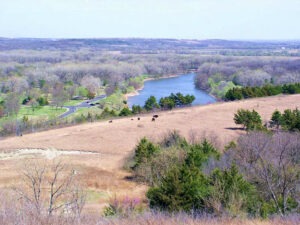Juniata, Kansas, a lost town in Pottawatomie County, was once a major point along the Fort Leavenworth-Fort Riley Military Road.
A crossing of the Big Blue River, Juniata was founded by Samuel D. Dyer, and the community was often referred to as Dyer’s town. It was located about three miles north of the present site of Manhattan.
Dyer was a native of Tennessee and came to Kansas in 1843. He was a major in the Black Hawk War. He had worked for the government for several years at Fort Scott. When Fort Riley was established in May 1853, he built the government ferry across the river. Dyer was an old man when he came to this county. His sons, Abraham and James, came with him. Abraham returned to Fort Scott and brought the remainder of the family back in November. They also brought a team of horses, a pony, two yokes of oxen, some cattle, sheep, and hogs.
Dyer and his family were the earliest settlers of Pottawatomie County, outside of those at St. Mary’s Mission. The government teams between Fort Riley and Fort Leavenworth constantly passed over the ferry. In addition to operating the ferry, he also kept a small store.
When the Kansas-Nebraska Act was passed in 1854, many settlers began moving into Kansas. Among the early settlers of Juniata was the Asahel Gilbert Allen family of Roxbury, Massachusetts, who arrived early in December 1854.
Samuel D. Dyer’s home served for several years as a voting precinct and a preaching place for ministers of all denominations. The first county jail was the cellar under the little store he kept. He was noted for generosity, and his place was designated a “free hotel.”
Residents of Juniata consisted of European and American families as well as Native Americans and a few African-Americans. Initially, the community was tightly knit and diverse and showed signs of prospering.
In 1855, construction began on a government bridge reportedly costing $10,000, and the settlement began to grow. A post office was established on July 25, 1855, with Seth J. Childs appointed the postmaster. The town’s layout was probably along a single main street, with small houses and shack-like buildings dotting this main trail.
Manhattan was established across the river that year, attracting many Free-State advocates.
A Sunday school was organized on April 27, 1856, with 31 pupils.
On June 3, 1856, the first quarterly meeting of the Methodist Episcopal Church was held in Juniata and was open to all denominations. However, a group of arriving settlers brought pro-slavery beliefs to the community during these tumultuous years of “Bleeding Kansas.” Though Dyer was a free-state Democrat, change began in the community, with one pioneer stating:
“Mr. Dyer has turned strong pro-slavery, and they have got a pro-slavery minister there of the Methodist Church… They have organized a church under the pro-slavery influence and intend to do all they can to bring slaves into Kansas and drive out the yankees for, they say, they do not want eastern men to rule the territory.”
The population of Juniata was soon divided along the slavery issue.
Juniata’s post office closed on August 5, 1856.
That year, ice and floods on the Big Blue River destroyed the $10,000 government bridge. That loss, accompanied by the perception that the town was a pro-slavey community across from Free-State Manhattan, caused it to lose appeal. Most of the remaining families of Juniata soon began to move to Manhattan, and the old settlement was soon abandoned.
However, Samuel Dyer remained there until he died in February 1875.
© Kathy Alexander/Legends of Kansas, July 2022.
Also See:
Extinct Towns of Pottawatomie County
Pottawatomie County Photo Gallery
Sources:
Cutler, William G; History of Kansas; A. T. Andreas, Chicago, IL, 1883.
Kansas Collections
Michael French, Juniata, Pottawatomie County, Lost Kansas Communities.

